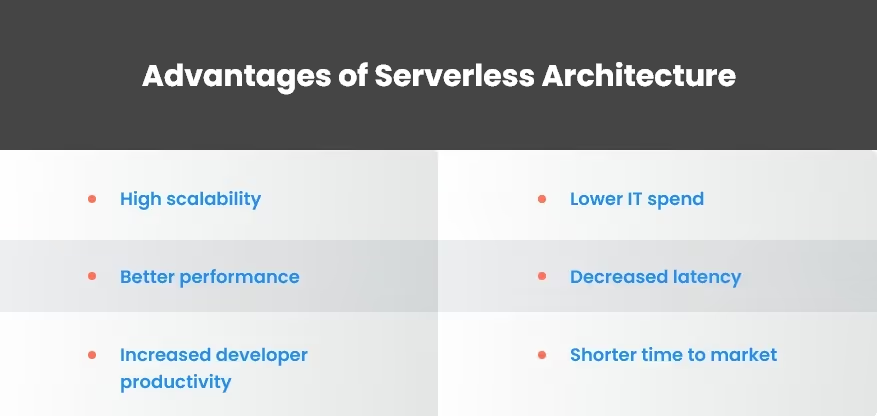Today, enterprises cannot afford to spend months on application development. They need software development tools, methodologies, and processes that are fast and easy. They also need to reduce costs and be able to quickly adapt to changes in the market. Serverless computing is the answer to these needs.Serverless architecture shifts the responsibility for infrastructure setup and management from developers to cloud service providers. With serverless, developers don't have to worry about provisioning, scaling, securing, and maintaining servers — cloud service providers take care of all of these functions. Amazon's AWS Lambda, Google's Cloud Run, and Microsoft Azure are some of the solutions available that allow enterprises to build serverless apps. Instead, developers can focus on the activities that let them deliver the greatest value: product development, rapid deployment, code optimization, and enhancements. There are many advantages to adopting serverless architecture. Serverless applications are high-performing and scalable — serverless architecture is a great choice for building chatbots and virtual assistants, IoT applications, image and video editing applications, and more. A serverless approach allows businesses to go to market faster and gain a competitive advantage. More and more enterprises are realizing this. Many popular brands have jumped on the serverless bandwagon — mobile communications company T-mobile, streaming service Netflix, and beverage maker Coca-Cola are some of the well-known brands using serverless architecture to deliver exceptional services today.
Why do we need serverless architecture?
Serverless computing is the natural evolution of cloud-based application development. These are some of the benefits it offers.

High scalability
Serverless applications can easily manage a large number of requests from users. Cloud service providers can dynamically allot the resources needed to execute your application. Instances can be created and removed in response to higher or lower utilization from application end-users. With resources being automatically scaled to your needs, you no longer have to worry about your application going down in the event of a traffic spike. Because resources are automatically scaled and provisioned, your application can run for longer without any risk of downtime.

Lower IT spend
With the traditional model, businesses would have to buy a number of fixed resources that would then sit idle most of the time. They would also have to invest in a team to monitor and maintain this hardware constantly. When you go serverless, you don’t have to consider hardware allocation at all. The need to have huge resource pools on standby at all times is eliminated. Because serverless cloud services are billed on a pay-per-use model, infrastructure and operations costs are significantly reduced, lowering your overall IT spend. You also save on the investment involved in maintaining an internal team to manage the infrastructure.
Reliable, high-performing applications
One of the biggest benefits of serverless architecture is that it improves application performance and reliability. This is because you no longer have to rely on a single server to handle all the traffic. With serverless architecture, applications are broken down or decomposed into smaller pieces and distributed across multiple servers. This helps to improve performance. It also gives you higher observability across the application and makes it easier to apply changes and fixes. The event-based system that serverless architecture uses means that failures are limited to small areas of the application and won't impact the entire application. Read An Overview of Microservices
Decreased latency, improved efficiency
In a traditional data center, there are many layers of infrastructure between the application and the end-user. This can lead to latency issues and longer response times for users. In a serverless environment, applications don't need to send requests to an origin server. This allows code to be run closer to the end-users, reducing the distance that requests have to travel, thus reducing latency. This reduced latency makes it easy for your business to serve content to end-users all around the world. Your application will remain highly responsive no matter where your end-users are located. And with no lag, your end-users will have a better experience.Read The Surging Importance of a Mobile-First Design Approach for Enterprise Web Projects
Higher productivity, greater value
Serverless computing allows developers to build and deploy applications without managing servers or runtime environments, planning for scalability, or provisioning resources in advance. Developers previously allocated to these functions can be freed up. Because of this, developers can focus on improving the application. As they spend more time enhancing application functionality and resolving any user experience challenges, end-users of the application get to have a better experience. Businesses can also use the additional resources to further develop their service portfolio. Since there are fewer challenges to contend with, businesses can focus more on innovation and expansion.

Shorter time to market
With no need to provision infrastructure, applications can be rapidly built and deployed in a matter of days or hours. New features can also be rolled out quickly and developers can quickly apply patches and fixes. Faster releases mean you can innovate faster. It also means that in case you need to pivot in response to something changing in the market, you can quickly do that. In the current climate, this agility is of prime importance for many businesses.
Challenges of going serverless
Although serverless architecture is a great option for businesses of any size, it does come with some challenges. Some of these are:Learning curve: It can take time and training for developers to become familiar with serverless architecture. This new paradigm requires a different approach to application development and deployment.Complexity of architecture: Serverless architecture involves breaking an application into many smaller pieces and deploying those across multiple servers. It can therefore take some time for developers to figure out how best to break their applications down.Security: Serverless applications run on the servers of third-party service providers. These can be configured to follow strict security guidelines, but if they aren't configured correctly, it might weaken the security of your application.Monitoring: Monitoring serverless applications can be harder than monitoring traditional applications since you also have to monitor the integrations between different parts of the application. The tools currently available for this are limited.Accurately predicting costs: Serverless computing’s pay-per-use model means that developers can't predict their costs in advance. This model might not be ideal for all businesses. Read Benefits of Creating Microservices Apps in an Advanced Production Environment
The serverless approach offers significant advantages
Despite its challenges, however, businesses that do adopt this technology overwhelmingly find that it helps them. According to a series of surveys conducted by IBM Market Development & Insights across 1,200 IT executives, developer executives, and developers, 85 percent of respondents feel that despite adoption challenges, it’s worth the effort to go serverless. And among respondents who are non-users, 68 percent are likely to adopt serverless architecture within the next two years. Serverless is an extremely efficient way of working. It can help to reduce your IT spending, improve resilience and latency, and increase productivity. It is also a more agile way of working, giving businesses the ability to quickly pivot in response to changes in the market. If you're looking for an efficient and agile way to develop digital experiences for your customers, then serverless architecture is the way to go.
.avif)









.jpg)









